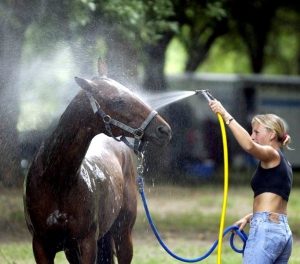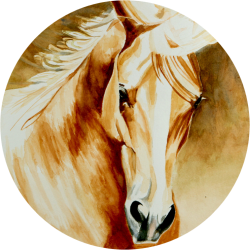It’s hot. Of course it’s hot, it’s August. I love it when somebody says: “but it’s a dry heat”.
Yeah, so is a convection oven. I can suffer indoors by the air conditioner with a frosty beverage in my hand. My horses don’t have that luxury. However, we must remember that horses are big, strong animals with an astounding ability to adapt. The thermometer should not dictate how we enjoy our horses, but higher temperatures do demand more careful management to ensure their health. It’s all about water.
The physiology of the horse is not much different than our own. We are more than half water and our entire metabolism is governed by water-based enzymes. Enzymes are proteins that act as microscopic machines that take the food and water we ingest and turn it into all the stuff of life. This occurs in a precise chemical environment so even a slight imbalance can have disastrous consequences. Crack an egg on a hot skillet and watch the clear liquid change to white solid in just a few seconds. This is analogous to heat damaging proteins in the horse’s brain. The protein machines essential for life are also subject to irreversible, potentially fatal changes when the body temperature exceeds a certain level-not even close to that of the skillet–and your brain turns into a soft-boiled egg.
When it is hot, we sweat – although ladies from the South “glow” – it still looks like sweat to the rest of us. The reason for this is obvious: evaporation. This physical property of water is part of what allows us to regulate our body temperature. Water, in the form of sweat, goes from liquid to gas and takes energy in the form of heat with it. Salts, aka electrolytes, are also lost, but the key is usually water. Water is lost through four body systems: respiratory (exhaled breath has a lot of water vapor in it), gastrointestinal, urinary and skin (sweat). As the temperature goes up, the demand for water increases and the average horse can drink up to 50 gallons of water on a hot day.
Although heat stress is most often seen in exercising horses, it can occur in horses housed in barns with poor ventilation or in paddocks without access to shade. Transporting horses in poorly ventilated trailers on very hot days is also risky. Symptoms can start with profuse sweating, elevations in respiration (greater than 40 breaths per minute), lethargy and loss of appetite. In severe cases, neurologic symptoms like stumbling, disorientation, and head pressing indicate heat stroke. Symptoms like these should be considered a life threatening emergency and veterinary help is imperative. Intravenous fluids and other treatments for shock should be started immediately.
There is a lot of mythology about horse care in general, and the management of overheated horses is no exception. In the recent thirty years or so, there have been some very good, carefully controlled studies about water and salt metabolism in horses that should have dispelled some of this lore, but some fables simply refuse to die. Here are just a few.
Never let a hot horse drink his fill, it may cause colic. False. A horse stomach holds up to two gallons, and the horse will stop drinking when he is full. The first sign of colic is when a horse stops eating and/or drinking, so he will stop when it becomes uncomfortable.
Never put cold water on a hot horse’s back. False. The best way to cool off a hot horse is with cold water and plenty of it. Keep him walking in the shade, this will increase the air flow over his body and improve evaporative efficiency.

Lots of cold water is the best way to cool off a hot horse.
Always use a blanket to prevent cooling from occurring too rapidly. False. After moving hay this summer, I have never once been tempted to put on a light jacket to cool off, I’m pretty sure my horse feels the same way.
Electrolyte paste will prevent dehydration. False. In fact, adding electrolytes (salt) above the daily requirement to the diet of the horse probably has no benefit. Dehydration, by definition, is a deficiency of water in the blood stream. Putting high concentrations of salt (electrolyte paste) in the stomach of a stressed horse will draw more water out of the blood stream and actually increase dehydration. This is why soaking a leg in water and Epsom’s salts will reduce swelling; the water in the inflamed tissues is attracted by osmosis to the salt in the soaking solution.
Solutions containing adequate concentrations of electrolytes are way too bitter to drink. If a horse is seriously dehydrated, he will need intravenous fluids to replenish both water and electrolytes rapidly. This requires a large volume and a few hours to deliver it. For example, a 1000 pound horse (450Kg) dehydrated 10% will need 45 liters of fluids-that’s about ten gallons. Since the stomach of the horse only holds about two gallons-you can see the problem.
Heat stress can usually be prevented by using a little care and common sense when riding. Avoid riding during the hottest part of the day, usually from noon to just before sundown. Allow easy access to water, and take breaks from strenuous exercise. Stay in the shade. Add fans and misters to barn isles and stalls. When possible, haul after dark or in the early mornings.
Summer is a great time to enjoy our horses. With a little common sense, we can keep it safe in all kinds of weather

